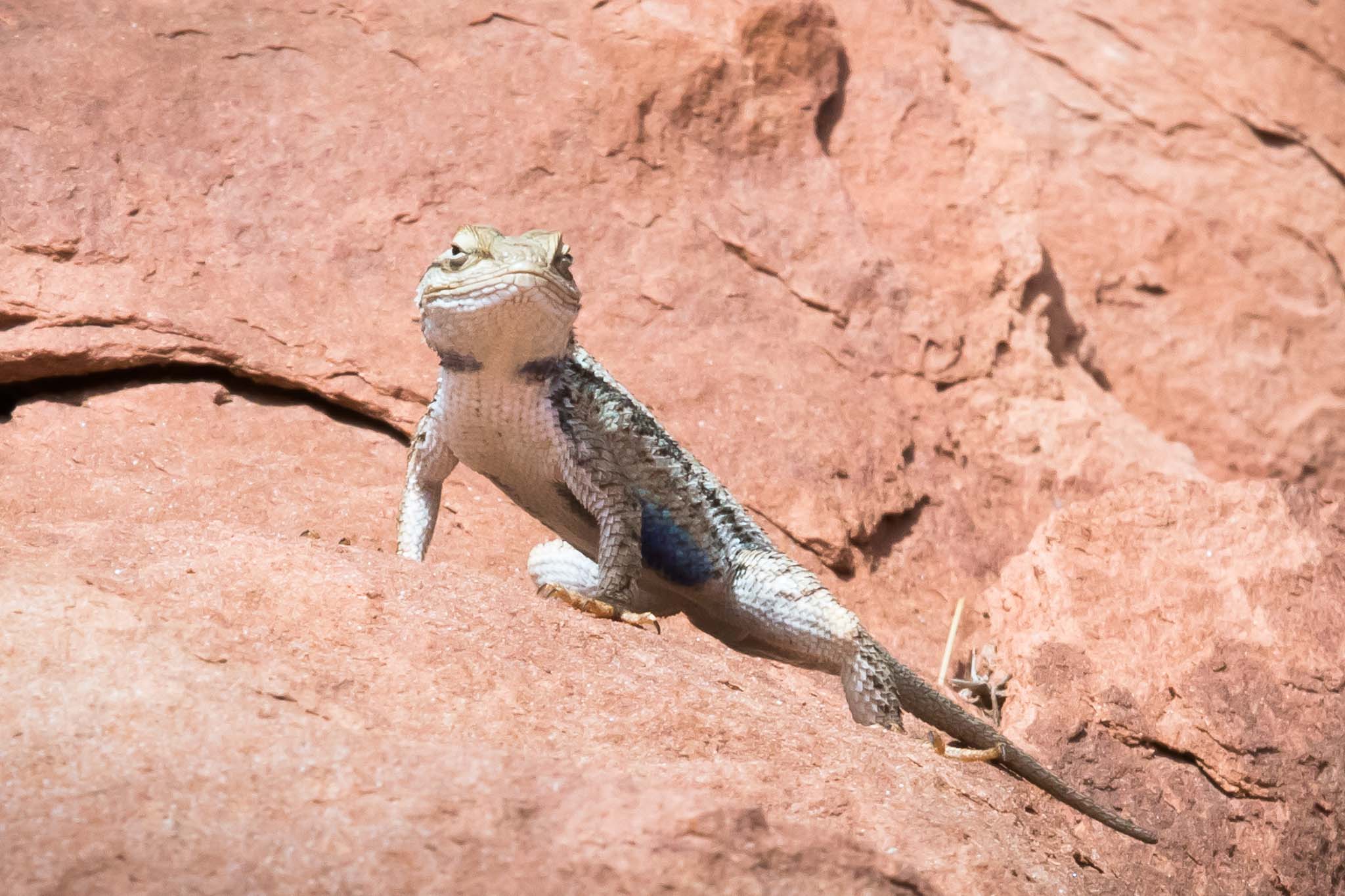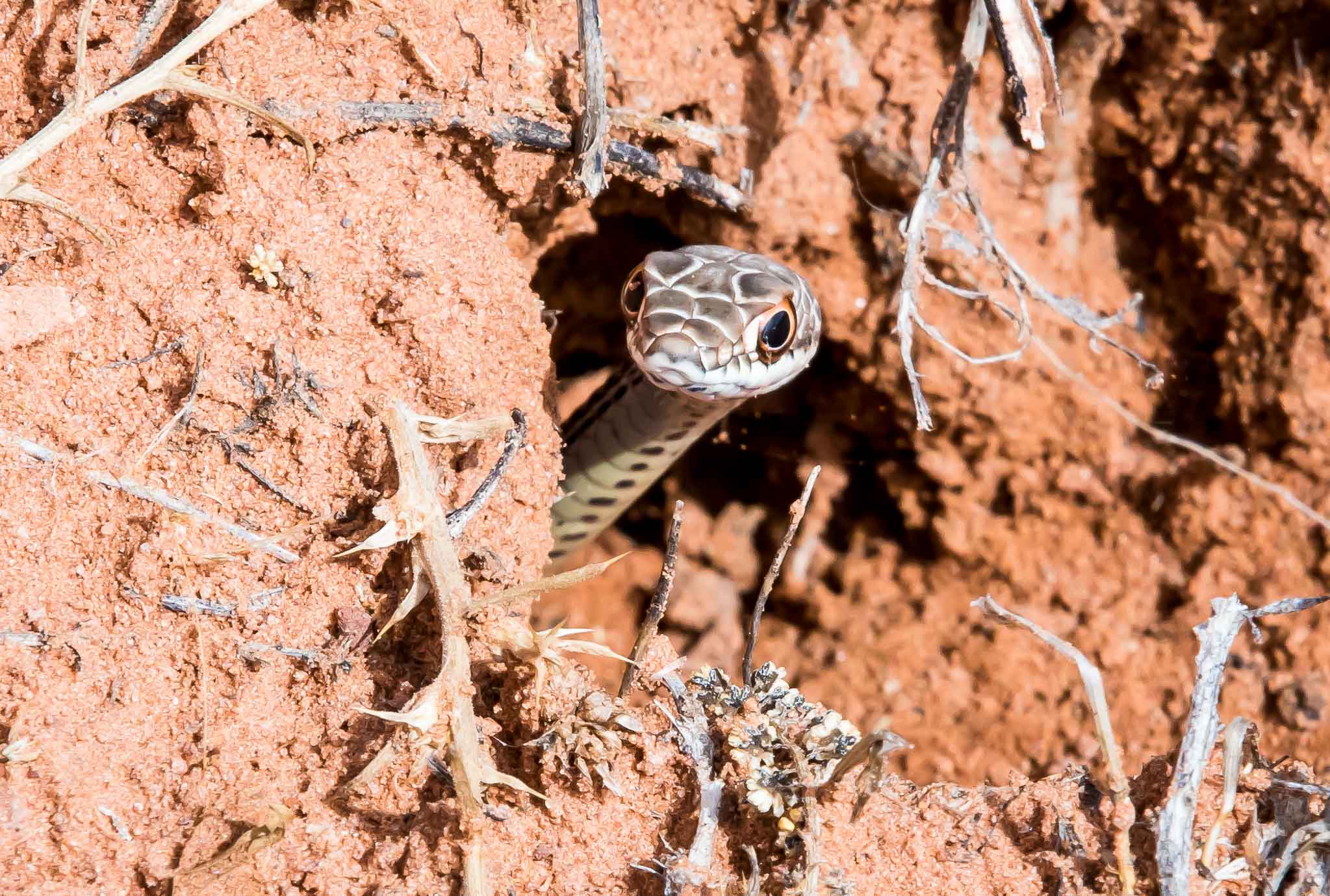Reptiles

Hold That Pose!
Painted Turtles, Bosque del Apache National Wildlife Refuge, San Antonio NM
Thanks, guys!

What's Up?
Common Sagebrush Lizard, Lockhard Basin Road, Monticello UT
This handsome fellow stood his ground about eye high on this rock giving me plenty of time to grab some portraits. Thanks buddy.

Dang, He's Still Here
Western Patch-nosed Snake, Lockhart Road, Monticello UT
These little guys are FAST!
When this cute little guy saw me (s)he made a mad dash for safety in a nearby burrow, quickly turned around and peered out to see what I was up to, gave me just time enough to get a few shots, and raced off into the scrub. The whole encounter lasted only a few seconds.
Addenda to Photos
Hold That Pose!
Painted Turtles, Bosque del Apache National Wildlife Refuge, San Antonio NM
December 13, 2023
Painted Turtle
The painted turtle (Chrysemys picta) is the most widespread native turtle of North America. It lives in relatively slow-moving fresh waters, from southern Canada to northern Mexico, and from the Atlantic to the Pacific. They have been shown to prefer large wetlands with long periods of inundation and emergent vegetation.[7] This species is one of the few that is specially adapted to tolerate freezing temperatures for extended periods of time due to an antifreeze-like substance in their blood that keeps their cells from freezing.[8] This turtle is a member of the genus Chrysemys, which is part of the pond turtle family Emydidae. Fossils show that the painted turtle existed 15 million years ago. Three regionally based subspecies (the eastern, midland, and western) evolved during the last ice age. The southern painted turtle (C. dorsalis) is alternately considered the only other species in Chrysemys, or another subspecies of C. picta.
Wikipedia
What's Up?
Common Sagebrush Lizard, Lockhard Basin Road, Monticello UT
October 8, 2015
Common Sagebrush Lizard, Sceloporus graciosus
The sagebrush lizard or sagebrush swift (Sceloporus graciosus) is a common species of phrynosomatid lizard found at mid to high altitudes in the western United States. It belongs to the genus Sceloporus (spiny lizards) in the Phrynosomatidae family of reptiles. Named after the sagebrush plants near which it is commonly found, the sagebrush lizard has keeled and spiny scales running along its dorsal surface.
The sagebrush lizard is similar to the western fence lizard, another Sceloporus species found in the western US. The sagebrush lizard can be distinguished from the western fence lizard in that the former is on average smaller and has finer scales. The keeled dorsal scales are typically gray or tan, but can be a variety of colors. The main (ground) color is broken by a lighter gray or tan stripe running down the center of the back (vertebral stripe) and two light stripes, one on either side of the lizard (dorsolateral stripes). S. graciosus will sometimes have orange markings on its sides.
Three regional races of the sagebrush lizard are recognized: the southern sagebrush lizard lives in Southern California, and the western and northern races are found in many western states, including Nevada, Oregon, Idaho, Colorado, Montana, Washington, New Mexico, Utah, Wyoming, North Dakota, South Dakota, Nebraska, and Arizona.
The sagebrush lizard is usually 4.7–8.9 cm (1.9–3.5 in) snout-to-vent length (SVL) when fully grown.[3] Hatchlings are about 25 mm (0.98 in) SVL. The sagebrush lizard looks very similar to the western fence lizard, but differs in that it is typically smaller and has an increased number of scales. In appearance, sagebrush lizards are grey, brown or olive, with hints of blue or green on the dorsal surface during the light phase, and they often have irregular banding patterns on the body and tail. They also often display a black bar on the shoulder, and a light lateral and dorsolateral line on both sides. The scales on the rear portion of the thigh are small and granular, while the armpit and lateral surface of the body is often rust-colored. Females have white or yellow bellies, and males have distinctive blue patches on the abdomen and throat, although the throat patch can be absent. Males also have enlarged postanal scales, and two areas of swelling at the base of the tail. During the breeding season, males may develop orange breeding colors. Young lizards look similar to adults, but lack the dark blue markings.
The sagebrush lizard is commonly observed in shrublands, but is also found in a variety of other habitats including coniferous forests, and piñon-juniper woodlands. They will bask on logs and rocky outcrops. They spend most of their time on the ground; however, they have the capability to climb to escape predators.
Wikipedia
Dang, He's Still Here
Western Patch-nosed Snake, Lockhart Road, Monticello UT
October 8, 2015
Western Patch-nosed Snake, Salvdora Hexalepis,
Salvadora hexalepis, the western patch-nosed snake, is a species of non-venomous colubrid snake, which is endemic to the southwestern United States and northern Mexico.
It is found in the southwestern United States in the states of Arizona, southern California, Nevada, southern New Mexico, and southwestern Texas. It is also found in northern Mexico in the Mexican states of Baja California, Baja California Sur, Chihuahua, Sinaloa, and Sonora.
Adults of Salvadora hexalepis are, on average, 20-46 inches (51–117 cm) in total length;[6] the record total length is 58 in (150 cm).
They have a distinctive, thick scale curved back over the top of the snout, and free at the edges.
All subspecies are yellowish with blackish lateral stripes in various arrangements.
The dorsal scales are smooth, and the anal plate is divided.
The western patch-nosed snake inhabits arid deserts in its area. It feeds upon lizards, snakes, reptile eggs, and small rodents.
4-10 eggs are laid during spring or early summer and hatch in August through September.
Wikipedia
